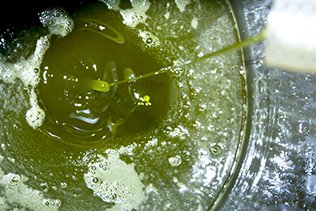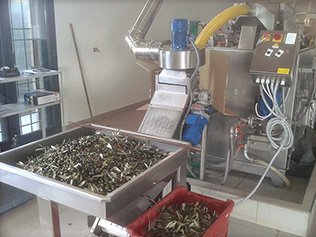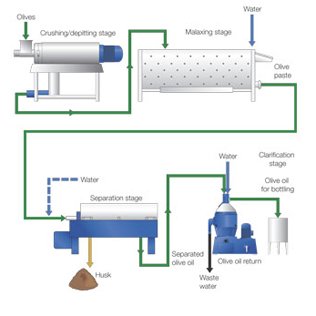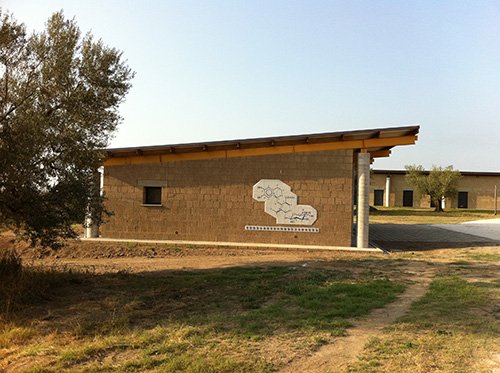TO HELP YOU LET GO, I WILL TELL YOU STORY: A STORY OF THE ABILITY TO MAKE AND APPRECIATE OLIVE OIL
Our story begins from the point of arrival to today.
Italy in general has an extremely favorable climate and environment for olive trees. Here we have over 500 varieties; the highest concentration of different varieties.
In Canino, we are a very unique territory. We are halfway between the sea 15kms to the west and the cone volcano (600 above sea level) of Lake Bolsena is 15 kms to the east. In 30 kilometers we have different terrains (sand, clay, rock, tuff, volcanic lapilli) and different microclimates.
Every year our oils are different because they come from different territories and microclimates: the sea, the lake, the volcano.
Here grows the Caninese variety, which is possibly the oldest native Italian variety, already documented in the Etruscan frescoes.
Here in Canino we have been making oil for around 3000 years. We have invented it to satisfy all the senses. Olive oil is a pleasure tool for the nose, mouth, senses and for our health in general.
To make a great quality oil is very difficult
Michelangelo said that he has done nothing: “the statue is already inside the block. I just remove the superfluous.” Even the oil is inside the olive and the miller must only extract it, damaging it a little as possible, however this is extremely complex.
Nevertheless, the oil that you get is a bridge to the peace of pleasure experienced. The concept of the oil takes you beyond time and into a still and infinite time. The time of life.
It is here you will find memes of your happy moments in the aromas of extra virgin olive oil. Understanding how to recognize the aromas of extra virgin olive oil is like recognizing what’s important to you. The fragrances of the mono-varietal extra virgin olive oils offer the peace of an infinite moment.
The great richness of extra virgin olive oil and the infinite variations of aromas and flavors of countless mono-varietal oils. A lettuce leaf and one hundred mono-varietal extra virgin olive oils can create one hundred different dishes.
In fact, the difference in life is made with refined ranges. Knowing how to live is knowing how to choose differences. The difference between elegance and gaudiness are in the details, as so in extra virgin olive oil are the aromas.
I&P WAS BORN TO PRODUCE THESE VARIATIONS
Paolo- the founder born near Bologna the center of the Villanovan culture from which the Etruscans expanded, founded the company in the center of Etruria. He did this precisely to produce an instrument of pleasure and satisfaction with all this tradition surrounding it.
In a certain sense I&P is the Kamasutra of oil because using only one oil is like all expecting to make love in the same position. I&P acquires small olive grove sand produces only one mono-varietal oil from each grove and from this comes the great value of mono-varietal from small groves; endless flavors that vary from place to place and from year to year. Learning to know them, taste them, to distinguish them and to use them by combining it with the right foods at the right moments provides infinite and profound emotions.
But these emotions come from far, so let’s go back into time.
“The warriors were washed in hot water in large artfully made bronze tubs and then spread with olive oil all over. Then they sat down at the table with food upon food. And they drank wine and sacrificed to Athena. ” (Iliad, Canto X).
7000 years ago in Haifa (Palestine) they had already made olive oil (remains of an archeological oil mill) and therefore they had already probably “invented” it much earlier.
3700 years ago the Code of Hammurabi regulated the trade of olive oil: the only found regulated in those time to demonstrate its importance and value.
The use of extra virgin olive oil is extremely ancient and, in the past, has enjoyed extraordinary consideration that is assumed a sacred connotation among many populations at the time.
The Etruscans made plentiful and varied use of olive oil; lush and fruitful olive groves represented an essential feature of the Etrurian landscape and the olive tree was considered so precious that it was the object of worship, present in the form of small twigs held in the hand by the priest, in every religious procession. Olives and their oil were one of the staple foods of Etruscan cuisine.
Etruscan society, perhaps born near Bologna with the Villanovian civilization, had strong oriental influences. Then it expanded southwards into present-day Tuscany and then into Lazio to reach Campania.
The pleasure of living was one of its cornerstones. It was also very open. The woman continued to carry her patronymic or her name even when married and like the man, was the owner of property rights and economic activities and in the literate classes (aristocrats, but also scribes and potters), she knew reading and writing. The women of the aristocracy could interpret the signs of the gods.
They had a philosophy that started from the bottom up to metaphysics and not vice versa, as happens in Western philosophies.
The Etruscans were dedicated to enjoying life in all its components.
We, descendants of the Etruscans, here in Canino in the center of Etruria, in the magical triangle Tarquinia, Tuscania, Vulci have given the last three kings to Rome (who built some of the most important monuments of Rome: The Circus Maximus, the Walls, the Temple of Jupiter and the Temple of Diana) and for 3000 years we have been growing olive trees and making oil here.
Then the Farnese family arrived throughout Tuscia and one of them, born in Canino, became Pope Paul III. Then the French arrived, and Napoleon’s brother Bonaparte (Luciano) became Prince of Canino.
As we have mentioned at the beginning, a common theme of this dense history has been the ability to make and appreciate olive oil.
The result is that here in Canino we are truly in a special and unique area. We are halfway between the sea 15kms to the west and the cone volcano (600 above sea level) of Lake Bolsena is 15 kms to the east. In 30 kilometers we have different terrains (sand, clay, rock, tuff, volcanic lapilli) and different microclimates.
Every year our oils are different because they come from different territories and microclimates: the sea, the lake, the volcano.
Here grows the Caninese variety, which is possibly the oldest native Italian variety, already documented in the Etruscan frescoes.
Here in Canino we have been making oil for around 3000 years. We have invented it to satisfy all the senses. Olive oil is a pleasure tool for the nose, mouth, senses and for our health in general.
AND SO, AS WE HAVE BEGAN: YOU, THE READER- HAVE NO FEAR. ALLOW YOURSELF TO GO AND TRY THE MANY DIFFERENT OILS I&P HAVE TO OFFER.
WHERE OUR MONOCULTIVAR OLIVES ARE BORN
The Company
The soil
The olive groves
The co-ordinates
Canino satellite coordinates: latitude 44.5588028 °, longitude -12.5778415 °
Sonnino satellite coordinates: latitude 41.4305 °, longitude – 13.2454 °
COME NASCONO I NOSTRI OLI MONOCULTIVAR
Tutti i passaggi dell’iter produttivo sono curati in modo rigoroso ed ogni olio porta in dote l’unicità dell’oliveto da cui proviene
Per seguire ancora più da vicino l’intera filiera produttiva oggi l’azienda può contare su un frantoio aziendale di proprietà, progettato e assemblato dall’azienda con i migliori macchinari.

La frangitura avviene entro Massimo 4 ore dalla raccolta ed è fatta col frantoio aziendale che utilizza un metodo di estrazione a ciclo continuo a due fasi. Il metodo permette di ridurre enormemente la superficie esposta all’ossigeno dell’aria, riducendo così notevolmente l’ossidazione con conseguente salvaguardia della qualità dell’olio; il metodo di estrazione a ciclo continuo a due fasi permette di ottenere oli con una maggiore concentrazione delle sostanze fenoliche, che sono quelle a maggiore attività antiossidante. La frangitura è a martelli o a dischi a seconda delle necessità, delle stagioni e delle cultivar lavorate.

Il sistema di estrazione dell’olio di oliva è stato progettato direttamente dal personale dell’azienda con due grandi fornitori leader mondiali, Mori Team e Alfa Laval, per consentire di differenziare il loro olio extra vergine di oliva rispetto ai prodotti standard, permettendo di esaltare la maggior parte delle caratteristiche di base di ciascuna coltura e le qualità intrinseche, mantenendole e migliorandole durante il processo di produzione. Il controllo delle temperature e della velocità lungo tutto il processo è impressionante.
L’unità risultante combina le più avanzate apparecchiature per il trattamento di olio d’oliva attualmente disponibili in un sistema integrato con un ingombro compatto.

Dopo la pulizia per rimuovere lo sporco e detriti, le olive vengono frantumate in pasta di olive utilizzando un martello o un disco di frantumazione. Alla macinazione segue la gramolazione, una lenta miscelazione in cui la pasta di olive è rimescolata in modo che gli enzimi vengono attivati e scattino i processi enzimatici (il più importante è la via della lipossigenasi). Ciò consente alle piccole gocce di olio di fondersi: le goccioline microscopiche si uniscono a quelle più grandi che vengono poi estratte utilizzando una centrifuga decanter. Questo processo separa l’olio dalla sansa umida.
L’ultima fase consiste nella chiarificazione, durante la quale viene rimosso dall’olio qualsiasi residuo di acqua utilizzando un filtro di cellulosa.



